Abstract
The supply of animal feed is one of the main concerns of producers in the aquaculture industry, including aspects such as the cost of fish flour and its nutritional balance. The aim of this study was the preparation of a pellet-type fish food using powdered Spirulina sp. cultivated as a protein source supplemented with agro-industrial waste, and its evaluation to comply with the necessary parameters for the elaboration of extruded pellets. Spirulina sp. was cultivated in a photobioreactor at a volume of 50 L, separated by decantation and dried. The proximal characterization was 6.79% ± 0.05 moisture, 6.93% ± 0.01 ash, 66.88% ± 0.33 protein, and 5.50% ± 0.26 fat. Subsequently, flours were prepared using cassava leaves, gliricidia leaves, and rice husks. The results for the cohesion showed that the flours obtained to comply with the necessary parameters for the elaboration of extruded food. The fish feed was prepared in pellet form using the formulation for fattening Tilapia: Spirulina sp. (20%), cassava leaf flour (50%), gliricidia leaf flour (20%) and flour of rice husk (10%). Floatation analysis showed that 60% of the pellets floated for more than 40 min, and 80% retained their shape for 4 h. The results show that the obtained product can be used as fish feed, due to the lowest disintegration, together with its great capacity for water absorption and especially, its greater flotage due to the expansion effect, are physic characteristic determinants so that the fish has more time to consume extruded diets and avoid losses.
1. Introduction
Agricultural production increased more than three times in the last 50 years due to the expansion of land for agricultural use, the technological contribution of the green revolution that influenced productivity, and the accelerated growth of the population [1]. This sector produces an average of 23.7 million tons of food per day worldwide [1].
Likewise, the agricultural waste production is estimated at 998 million tons per year, made up of animal waste, food processing waste, crop waste such as corn stalks, sugarcane bagasse, discarded fruit and vegetables, and pruning, among others. Organic waste can represent up to 80 percent of the total solid waste generated on any farm [2].
The growth of world agricultural production creates greater pressure on the environment, causing negative impacts on soil, air, and water resources [1,3]. Furthermore, it can lead to the loss and degradation of natural ecosystems [4].
In general, agriculture is responsible for 21% of greenhouse gas emissions [1]. Recently, this situation has promoted a more sustainable development model, which implies relevant changes in current agricultural production systems [5]. For example, use of agricultural residues to fertilize soils and contribute to the dispersion of chemical and biological pollutants in terrestrial environments [6], the use of residues for cooking and heating [7], as well as the production of biogas [8] and the production of alternative protein for animal feed [9].
These processes are classified as waste recovery waste into more suitable products, with opportunities to apply industrial symbiosis in waste recovery. Consequently, it has potential to provide economic, social, and environmental benefits. These strategies support the development of a circular economy in the food sector by closing the loop and using waste as a resource, an approach encouraged by recent policies in Europe [10].
Circular economy is defined as the conservation of the products value, materials, and resources in the economy for a long period with the reduction of waste generation. The circular economy aims to improve the efficiency of resource use and the recovery of waste materials to reduce the emission of additional fossil carbon during manufacturing and extraction processes. In this sense, the sustainable and synergistic use of resources should be encouraged with bioeconomy instead of increasing pressure on resources [5].
One of the practices that represent low use of agricultural land is the production of animal feed using new protein sources such as insect meal, micro, and macroalgae, protein-rich by-products of the food industry, and unicellular protein [9], as well as taking advantage of poultry and papaya processing waste used as alternative proteins to replace fishmeal [11].
In aquaculture, the supply of animal feed is one of the main concerns of producers in this industry [12] due to limited resources such as land, water, and energy [13], where 560 Mha, or about 40% of the world’s agricultural land in the production of animal feed [14].
Feeding costs and quality are the main constraints to the emergence of aquaculture in developing countries. Fish feeding represents 60–75% of the total cost of fish production. The high cost of food is due to the high cost of fish flour, the main ingredient in commercial food formulation [15].
The market drives substitute marine ingredients to different plant-based ingredients, and novel food ingredients are driven by price, availability, and legislation [16]. Alternative feeding solutions such as the use of insects can have unexpected side effects when implemented and expanded to industrial production [12,13].
The use of fish flour decreases every year, reaching an approximate consumption of 141,000 tons in 2017, of which 69% was used for aquaculture in competition with food security [17]. The use of microalgae as a fish feed or food supplement could reduce the burden on fish flour-based aquaculture; and reduce the gap between fish production and demand. Similarly, when microalgae are mixed with animal feed for the required nutrient portion, the requirement of grains and millet could be reduced [18].
Microalgae have several attractive characteristics for large-scale sustainable production, such as high biomass yields per unit area and grow ability on non-arable land using non-potable water or even saltwater [19].
The Spirulina sp. microalgae is a potential source of nutrients as food supplementation in aquaculture due to its high content of protein and absorbable compounds [20], as well as antioxidant properties, improving growth, feeding efficiency, and the physiological response to disease in various fish species at low production cost [21].
The production of fish feed using locally available ingredients at a low cost is crucial for the development and sustainability of aquaculture [15,22].
In this study, a pelletized fish food production was developed using agro-industrial wastes composed of cassava leaf flour, gliricidia leaves, and rice husk, enhanced with powder Spirulina sp. as a protein source. A set of photobioreactors to produce Spirulina sp. were installed in rural areas of the Department of Antioquia, Colombia, and a cooperative production model was implemented with farmers to guarantee the long-term sustainability of the initiative.
2. Materials and Methods
2.1. Raw Materials for the Processing of Fish Food
The raw materials used to prepare fish food were: Spirulina sp. obtained from CIBIOT lad at Universidad Pontificia Bolivariana, cassava leaves (CL) and gliricidia leaves (GL) from the field -San Carlos Antioquia- Colombia, and rice husk (RH) from the Plaza Mayorista de Medellín.
2.2. Spirulina sp. Production
The Spirulina sp. culture was developed in a 50 L photobioreactor, bubbling system and, an inoculum concentration equivalent to 20% at room temperature.
The culture medium used to produce this Spirulina sp. was the modified Zarrouk medium, as shown in Table 1. The trace metal solution was composed of Boric acid 23.13 mol∙m−3, Manganese chloride tetrahydrate 4.55 mol∙m−3, Zinc sulfate heptahydrate 0.52 mol∙m−3, Copper sulfate pentahydrate 0.16 mol∙m−3, Sodium molybdate dihydrate 0.05 mol∙m−3.

Table 1.
Modified Zarrouk medium.
The production of Spirulina sp. was monitored every 4 days in a physical way employing photographic recording, microscopic review, and determination of the optical density by the spectrophotometric method between 400 and 700 nm.
Subsequently, the biomass was separated by decantation and subjected to convection oven drying for 24 h at 65 °C to avoid protein denaturation and subsequent maceration of the biomass on a dry basis using a mortar. The algal biomass on a dry basis, the percentage of moisture, protein, ash, and fat was determined. To determine the moisture content, the AOAC 964.22 method was used, the wet sample was taken to the drying oven at 105 °C for 24 h. The samples were analyzed in duplicate, and the results were expressed as a percentage of moisture.
Ash was determined by calcining the samples in an electric muffle (TERMOLYNE, model 1300), at a temperature of 550 °C for 4 h (AOAC 1990). The results obtained were expressed as a percentage of ash.
The protein percentage was determined indirectly using elemental analysis (CHON) (Carbon: AOAC 949.14, Hydrogen: AOAC 949.14, Nitrogen: AOA 984.13). The analysis was performed using Thermo Scientific FLASH 2000 Analyzer, Organic Elemental Analyzer.
For the determination of fat content, the modified Blight and Dyer method, adopted by AOAC in 1990 was used. The samples were analyzed in duplicate, and the results were expressed as a percentage of fat.
2.3. Manufacture of Flours from Agro-Industrial Waste
To produce flour from the raw materials (CL, GL, and RH), a milling process was carried out using a TE-651/2 Moihno mill from Rotor TECNAL. Each raw material was separated three times using mesh sieves numbers 10, 20, and 30, respectively. Subsequently, screening was carried out using sieves 12, 16, 20, 30 and 40, finally, the particle size distribution was determined according to ASTM E 11-61, and particle size less than 420 µm was selected (Sieve No. 40).
Both cassava and gliricidia leaves were previously subjected to a washing process with acetic acid of 200 ppm concentration for 10 min, then they were subjected to a drying process at 60 °C by oven convection for 48 h.
The flours were characterized by performing a proximal analysis in duplicate: moisture according to the AOAC 964.22 method, ash by calcination, the percentage of protein indirectly by elemental analysis using a Thermo Scientific FLASH 2000 equipment, Organic Elemental Analyzer and fat by the Blight method, and modified Dyer, adopted by AOAC in 1990.
The particle size of the flours was determined through image analysis using a stereomicroscope (transmitted light) with a 4.0× Nikon SMZ (500 objective) and a Nikon DS-Vi1 digital camera connected to a USB interface adapted to the system. The capture was made with a constant focal length and standardized light conditions. Images were analyzed with Image J software (V2.1, Optika Vision Lite, Ponteranica, Italy).
The Cohesion Index (CI) was determined using a 48 mm diameter and 10 mm high rotary blade [23,24] while the flow characteristics of the flours were evaluated using a TA texturometer. X T PLUS Texture Analyzer (Stable Micro Systems, Medellín, CO, USA) [23].
2.4. Processing of Food for Fish
The concentrate was prepared using the nutritional requirements of Red Tilapia. Three diets were formulated and manufactured aiming to have diets with similar protein contents that could be used at different times of the year where there is variation in the availability of raw materials to produce fish food. A balanced feed with a net protein content of about 35% was formulated for the formulations. The ingredients of the formulation were: Spirulina sp. powder, cassava leaf flour, gliricidia leaf flour, and rice husk flour, according to the formulation shown in Table 2.

Table 2.
Percentages of flours used in the formulation of fish feed (mass percent, dry basis).
The prepared homogenous blend of flours was extruded in an extruder (Haake Polylab OS). Experiments were performed at a screw speed of 300 rpm and feed screw speed of 175 rpm. The barrel temperature was 100 °C. The configurations of extruder are same as discussed by Seth and Rajamanickam [25].
The extrusion process for the formation of the pellets was carried out by mixing the flours until homogeneity was achieved according to the formulations shown in Table 2, then water was added during the stirring process until reaching 30% moisture in the mixture and then they were processed in a 150 mm long (L) and 10 mm diameter (D) single worm screw extruder with a 15:1 L/D ratio. The compression ratio of the screw was 5:1 and the diameter of the hole of the nozzle used was 5 mm, temperature 127.5 °C, speed 160 (rpm), and moisture 30%. The extruded cords were cut into pellets, with a length of approximately 5 mm. These were subsequently dried in a BINDER oven at 60 °C until reaching a moisture of 10 ± 0.5%. Feed pellets were not coated with fish oil, as usually performed during large-scale production as we wanted to exclude the impact of a coating step on the quality of the fish feed. The pellets were determined to have floating and stability in water.
For the floating test 10 pellets were taken and deposited in a beaker with 400 mL of water at 25 °C, every 5 min the pellets that were kept on the surface were counted and the percentage of floating was determined by the method proposed by Arroyo [26].
For the stability test in water, 8 g sample of pellets was deposited in a beaker with 500 mL of distilled water at 25 °C, without stirring, then this mixture was passed through a # 8 mesh sieve allowing the solid particles to be retained. The mesh along with the sample was dried using a Thermolab convection dryer for 24 h at 60 °C. The stability of the pellet in terms of dry matter retention (DMR) was calculated with the weight of the dry sample using
where, DMR: dry matter retention (%); PWbi: pellet weight before immersion (kg); PWai, pellet weight after immersion (kg).
3. Results and Discussion
3.1. Raw Materials for the Processing of Fish Food
3.1.1. Spirulina sp.
In this research, Spirulina sp. was cultivated to be used as a source of protein in the elaboration of fish feed, between 51 and 71% by dry weight, essential and nonessential amino acids. The protein content of Spirulina sp. is higher when compared to unicellular algae and cyanobacteria, they also contain four times more absorbable compounds than protein in meat [20,27].
Spirulina sp. as an additive in animal feed improves growth, feeding efficiency, and the physiological response to disease in various fish species [28,29]. Also, it has received certification by the Food and Drug Administration (FDA) as a food or dietary supplement.
Studies by Nevien et al. [21] evaluated the effect of dietary supplementation for Tilapia using Spirulina platensis showing improvements in markers of liver and kidney damage in fish exposed to subacute diazinon toxicity (DZN). Besides, biochemical markers were improved through the increase of albumin and globulins with a significant decrease in glucose and cholesterol. Furthermore, there was an improvement in the liver, kidneys, and gills after being exposed to DZN where a significant increase in tissue antioxidant activity was observed with a significant decrease in lipid peroxidation levels [21].
Spirulina platensis was also evaluated as a 1% dietary supplement in common carp (Cyprinus carpio L.) induced by oxidative stress and Atrazine inflammation (ATZ) [30]. In Figure 1, the cultivation and adaptation of Spirulina sp. Cyanobacteria in a 50 L bioreactor are shown, using an inoculum concentration equivalent to 20%.
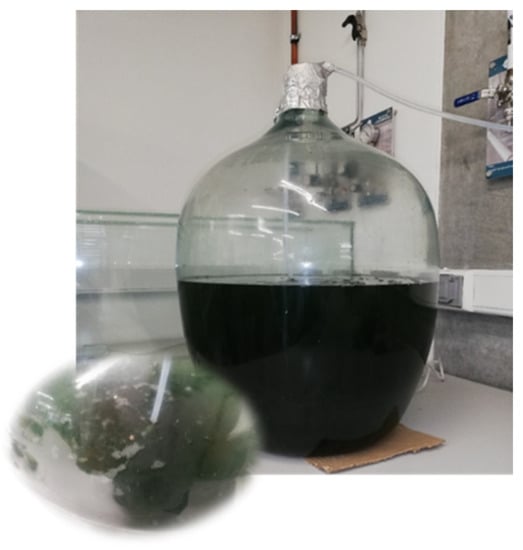
Figure 1.
Culture of Spirulina sp. in a 50 L bioreactor.
One of the main nutrients required by Spirulina sp., for its growth is the source of Carbon, one of the direct sources in controlled environments, is sodium bicarbonate, commercial or analytical grade, which not only acts as a medium that provides carbon to the cultivation but also regulates its alkaline conditions; relevant factor for maintaining the sterility of the medium and the pH in a range of 9 to 11 [31,32].
Similarly, as evidenced in the culture medium, this cyanobacterium requires a source of Nitrogen in the medium, generally supplied by NaNO3, which is essential for its growth. This source is also required for the synthesis of amino acids that structure proteins and other cellular components such as phycocyanin, the main pigment of phycobiliproteins that, in addition to having a photosynthetic primary function, help the reserve of cellular nitrogen [32,33,34].
The cultivation of Spirulina sp. requires a source such as phosphorus, which is essential in the performance of this cyanobacterium because it maintains the production of biomass in the culture; the form that the Phosphorus of Spirulina sp. acquires is through inorganic phosphates such as H2PO4− or HPO42−. In Figure 2, it is shown the follow-up to the Spirulina sp. culture, to show the adaptation and growth of the culture.
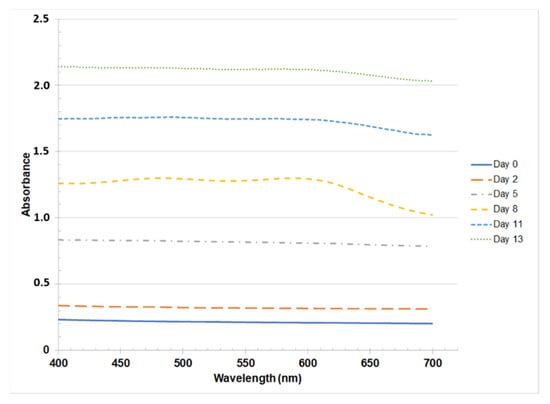
Figure 2.
Monitoring of Spirulina sp. by optical density between 400 and 700 nm.
In Figure 2, the adaptation of Spirulina sp. to the culture conditions is evidenced, including factors such as pH, light intensity, presence of contaminants, temperature, presence of bicarbonate ions, nitrogen source, type of bioreactor, initial biomass concentration and population density [35,36,37].
In the same way in Figure 3, the follow-up made to the culture of Spirulina sp., under the microscope Motic brand binocular-1100100401401 ba210led, is evidenced, using the 10X/0.25 (WD 17.4 mm) objective.
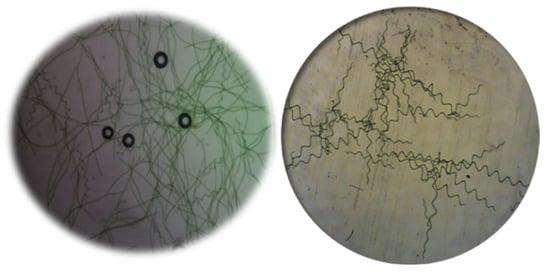
Figure 3.
Monitoring of Spirulina sp. under a microscope Motic brand binocular-1100100401401 ba210led, using the 10X/0.25 (WD 17.4 mm) objective.
In Figure 3, it is observed that the morphology of Spirulina sp., has a spiral-shaped structure, composed of multicellular cylindrical trichomes, which are arranged in the form of an open helix, along its length, where environmental factors, such as temperature and physical and chemical conditions, affect the helix geometry [31,36].
After the production of the Spirulina sp. biomass, it was separated by decantation as shown in Figure 4.
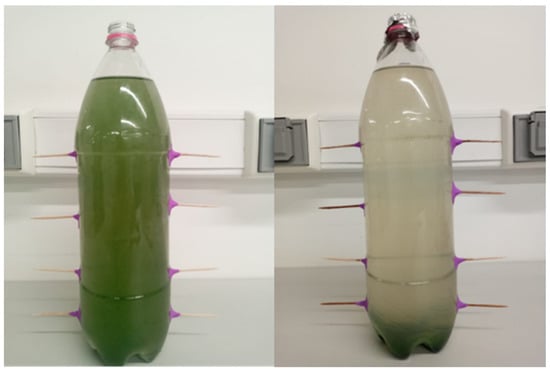
Figure 4.
Decantation process of Spirulina sp.
In Figure 4, the decanting process of the Spirulina sp. culture is evidenced, and later this was subjected to a convection oven drying process for 24 h at a temperature of 65 °C, to avoid protein denaturation, where studies carried out by Pantoja et al., show that the best temperature for oven drying of algal biomass is 52 °C and the exposure time of 3 to 4 days, as it is a heat-labile product, which starts at 65 °C to decompose into its nutritional properties, as proteins are denatured and great content of minerals and vitamins is lost [38].
Subsequently, upon obtaining the biomass on a dry basis, this was characterized, obtaining a percentage of 6.79% ± 0.05 of moisture, 6.93% ± 0.01 of ash, 66.88% ± 0.33 of protein and 5.50% ± 0.26 of fat. The above coincides with studies carried out by Lara et al. [39], who present this cyanobacterium with great potential in protein biosynthesis and growth. Furthermore, the results show that cultivated Spirulina sp. can be used as food for fish, especially Tilapia. These require a source of protein of 35–45% and fat of 10–15% [40,41].
The results of the Spirulina sp. cultivated in this investigation present protein values of 66.88% ± 0.33, values that are compared with the Arthrospira platensis species that have up to 70%. The rest of the algae species average around 40% protein content, which is relatively high compared to other plant sources such as soy (38%), rice (~10%), pea (2.8%) or even animal sources like milk (4%) or eggs (13%). Algae are not only high in protein, but that protein’s composition is much richer in essential amino acids compared to common plant proteins [19,27,42].
Microalgae can be produced in large volumes at relatively low costs, and reportedly can produce 7000 to 10,000 kg per hectare per year, making it a potential source of protein for aquaculture [37,43].
3.1.2. Flours Produced from Agro-Industrial Waste
The raw materials for the elaboration of the fish concentrate were selected according to the protein content, the nutritional quality, the availability of the raw material and the low costs tending towards the sustainability of fish farming.
Therefore, in this research agricultural residual biomasses were used: cassava leaves (Manihot esculenta), gliricidia leaves (Gliricidia sepium), and rice husk (Oryza sativa) to produce flours as raw materials in the production of fish food.
The market has been promoting the substitution of marine ingredients for a variety of ingredients of plant origin with positive socio-economic and environmental impacts [16,18] to improve local fish production, as it remains marginal with low yields [15].
The residual biomass generated from cassava cultivation on an annual average is 13.39 Ton/Ha, while for gliricidia cultivation it is an annual average of 2.25 Ton/Ha [44] and 1.6 Ton/Ha of rice husk, what guarantees local raw material. Today, finding sustainable raw materials is a major obstacle and has become a priority among stakeholders for fish feed production [13].
Cassava cultivation is distributed in diverse tropical countries with an estimated annual production of 291.9 million tons. The crop is the most important source of carbohydrates in producing countries. Both the roots and the leaves of the cassava can be used as food. Cassava is the most important source of carbohydrates in producing countries and can additionally contribute to the supply of proteins, micronutrients, and minerals [8].
Cassava is also the third most important source of calories in the tropics and the sixth most important crop in annual global production. Cassava crop is relevant for small farmers and large-scale plantations because of its low nutrient requirement, the ability to tolerate dry conditions, and the easy propagation at a low cost. The reliance on this crop is expected to increase as the global climate changes [45].
Although cassava leaves are an important source of carbohydrates and contribute to the supply of proteins, micronutrients and minerals, they must be detoxified before being used in animal or human nutrition due to the cyanogenic components that vary in concentration depending on the variety, genetics and growth stage [8]. Cyanogenic compounds release hydrogen cyanide. The degree of toxicity is altered by plant breeding, agricultural practice, environmental conditions, and food preparation methods [45].
Cyanide, in cassava leaves, can be found as free cyanide (approx. 10% lotaustraline) and as bound cyanide (approx. 90% linamarin), the latter being the contributor of the cyanide ion for the formation of hydrocyanic acid as free cyanide.
The crushing process in cassava leaves allows the enzyme linamarase to act on limarin due to the increase in the surface area obtained with the breakdown of cell walls during crushing. Increasing the proportion of free cyanide to ranges between 30–40%. Then, the free cyanide is eliminated during the dehydration process due to the favor of the hydrolytic reaction with long drying times and low temperatures.
Table 3 shows the characterization of raw materials used in this study, in mass percentage.

Table 3.
Characterization of raw materials, in mass percentage.
The results of Table 3 show that the moisture percentages of the raw materials were less than 13%, this being considered a good quality factor framed in the codex standard 176-1989 and codex standard 193-1995 [46].
Gliricidia is a plant that spreads rapidly. In Brazil, Gliricidia has often considered an invasive or weedy species and is employed as a nitrogen source and fixer in organic agriculture [4].
Gliricidia plant extracts showed high potent anthelmintic effects in the studies performed by Romero et al. [47]. The active compounds in gliricidia comprise glycosylated flavonoids, methoxy phenols, phenylpropanoids, anthraquinone glycosides, amino acids, and glycosylated phenolic acids. These compounds represent an alternative method to control gyrodactylid infections in tilapia [48].
Figure 5 shows the analysis of the flour samples analyzed with the stereomicroscope showed variable particle sizes where most of them were below 0.5 mm (500 µm).
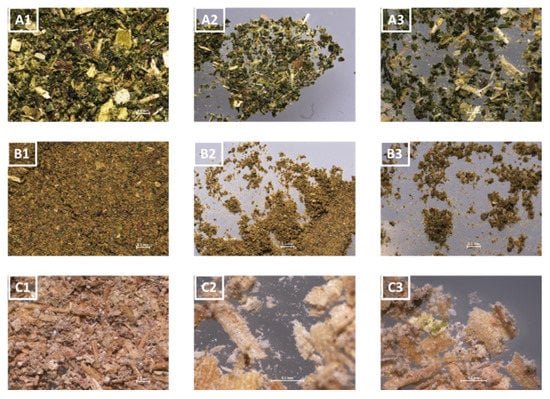
Figure 5.
Analysis of the flour samples analyzed with the stereomicroscope. (A1–A3) correspond to cassava leaf flour; (B1–B3) to gliricidia leaf flour; and (C1–C3) to rice husk flour.
The particle size distribution was 79% less than 500 µm and 21% greater than 500 µm for cassava leaf flour (Figure 5(A1)), 95% and 5% for gliricidia leaf flour (Figure 5(B1)), and 90% and 10% for rice husk flour (Figure 5(C1)).
Figure 5(A2,A3) (cassava leaf flour), Figure 5(B2,B3) (gliricidia leaf flour) and Figure 5(C2,C3) (rice husk flour) show agglomerations between the particles below 500 µm, while around the particles above 500 µm small particles are observed adhering. The above effect can be associated with the drying process of the raw materials, the electrostatic effects, and van der Waals forces. Agglomeration characteristics are widely desired for extruded food processes in both human and animal feed [49]. An important application of the agglomeration process is in the production of instant products in which the primary particles are agglomerated to give a product in the form of a granule. In the production of fish feed, agglomeration improves the characteristics of the extrudate in terms of its wettability, dispersibility, and dissolution [50]. Figure 6 shows the cohesion index of the raw materials.
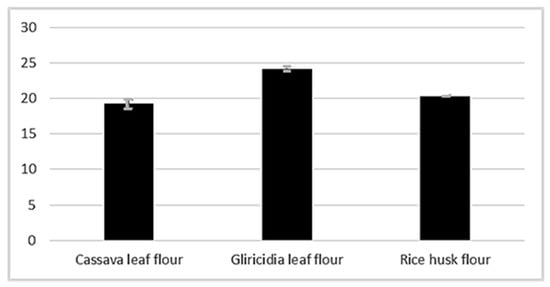
Figure 6.
Cohesion index of raw materials.
The cohesion index for cassava leaf flour, gliricidia leaf flour, and rice husk flour were 19.22, 24.14, and 20.29, respectively. According to IC-based powder classification [24], all flour samples in this study are classified as extremely cohesive powders. The cohesion index obtained is consistent with the images obtained using the stereomicroscope where they show a high attraction between particles. Similarly, cohesion indices greater than 19 are evidence of large inter particulate cohesion forces such as solid bridges, liquid bridges, van der Waals interactions [51], electrostatic forces and mechanical interlocks [49].
The cohesion index results confirm that the flours can be used in the elaboration of animal feed, especially in extruded foods, since a reduction in the particle size also increases the contact area between the particles, thus increasing the cohesive forces [24].
The results of particle size and cohesion indexes show that the flours obtained to comply with the necessary parameters for the elaboration of extruded food for fish [50].
Figure 7 shows the results of the analysis of powders at different speeds.
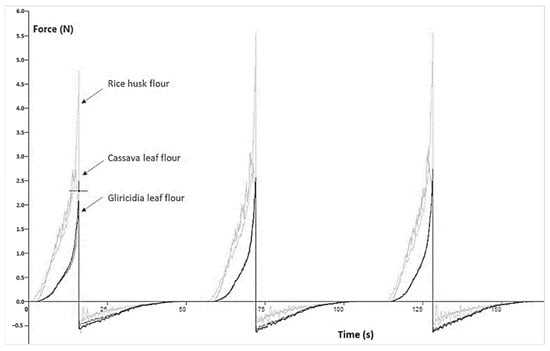
Figure 7.
Powder analysis at different speeds.
The forces involved in the powder flow are gravity, friction, cohesion (attraction between particles), and adhesion (attraction between the particle and the walls of the container). The flow curve of each sample was obtained during the compression and decompression test by performing three cycles for each powder sample, without adding any binder liquid.
Figure 7 shows that all samples follow a similar pattern on the graphs of the three compression and decompression cycles indicating reproducible behavior for each powder during the test. The area of the compression zone is always higher than that of the decompression zone for all samples, indicating that less energy is required to decompress the powder compared to compression. This shows greater bonding forces, hydrogen bonds, and Van der Walls forces within the particle and fewer forces acting between the particles [52].
The maximum peak force obtained with cassava leaf flour is around 2.6 N, for gliricidia leaf flour around 2 N and rice husk flour around 4.8 N. On the other hand, lower force peaks indicate that more energy is required for the compression of rice husk flour than for cassava leaf flours and gliricidia leaf flour, indicating greater stiffness between the flour particles of rice husk compared to other flours.
Gliricidia leaf flour, having lower force peaks, evidences the presence of protein and its ease of water absorption, acting as hydrocolloids and, therefore, quickly absorbing moisture, this is consistent with the protein results obtained (25.63%) [53]. The high force peak in rice husk flour (4.8 N) indicates the presence of high amounts of cellulosic compounds that provide greater rigidity to the macroparticles.
Powder analysis results confirm that the particle size of the raw materials can play an important role in terms of the parameters of the extrusion system and the quality of the granules. The correspondence between particle size, cohesion index, extrusion system parameters, and extrudate quality have already been reported for other extruded foods and food products [54]. The results obtained in the analysis of the powder for the flours, as well as the results of the previous analysis, indicate that it is possible to elaborate extruded fish feeds with adequate physical characteristics in terms of sinking, floating and degradation [50].
3.2. Development of Fish Food
An affordable quality feed will make fish farming attractive to private investors and increase fish production. When evaluating ingredients for use in the aquaculture sector, several aspects deserve attention such as ingredient availability, accessibility, and nutrient composition. The basic nutrient that cannot be compromised in the choice of ingredients for the formulation and production of food is a protein [15].
In this research, three formulations were developed that provide nutritional requirements according to the availability of the raw material at each time of the year, regardless of the abundance or scarcity of it, so that fish feed can be produced at any time of the year.
The fish feed formulation shown in Table 2 was made based on the nutritional needs of Red Tilapia, although it can be used for other fish species.
Formulation 3 was taken for the analyses, which provides the necessary nutrients for fattening Tilapia: Spirulina sp. (20%), cassava leaf flour (50%), gliricidia leaf flour (20%) and flour of rice husk (10%).
The pellets were made following the formulation. The procedure allowed the incorporation of air into the pellets and the obtaining of semi-smooth walls that trapped air inside the pellet, thus facilitating the floating process, as shown in Figure 8.
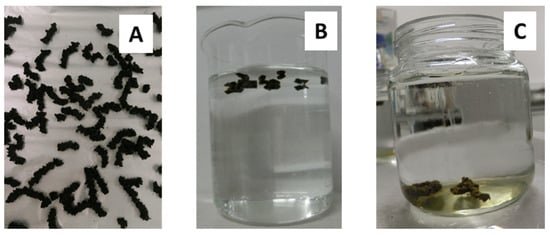
Figure 8.
Fish food aspect and behavior. (A): Pellets, (B): Floating, (C): Stability.
To measure the floating of the pellet, a measurement was taken of the time in minutes it takes for the pellet to sink, in this sense, 30% of the pellets sank during the first 10 s, 10% floated for 20 min and the remaining 60% of the pellets floated for more than 40 min. It was observed that the moisture of the pellet during extrusion and the final drying of the pellet influence on the floating times, the combination between extrusion temperature between 110 °C and 120 °C and the final drying of the pellets at 60 °C until achieving a final moisture between 10–15% in dry weight, generate long floating times, on the other hand, low temperatures during the extrusion process prevent the generation of water vapor that generates porosities inside the pellet, porosities where small traps are trapped air particles that favors the floating of the mixture generated an increasing trend in the floating time of the pellets [38]. Fish feed and its tests are shown in Figure 8.
Comparing the results of the feed for fish in pellets developed in this research with the nutritional contribution of the formulation with the nutritional requirements of the tilapia in the growth stage are widely covered both at the level of proximal composition, as well as vitamins, amino acids, and minerals. The studies show that the Spirulina platensis protein concentrate exhibits a high protein digestibility rate of 87.45–97.81% [18], as shown un Table 4.

Table 4.
Tilapia: Nutritional need vs supply pellets.
The use of Spirulina sp. incorporates essential amino acids, proteins, polysaccharides.
The use of cassava leaf flour and gliricidia leaf flour are a good source of protein as well as some amino acids, including methionine, arginine, isoleucine, and leucine. The use of rice husk leaf flour incorporates, in addition to amino acids, the B vitamins and minerals, which cover the nutritional needs of Tilapia [63].
Developed fish feed is a source of micronutrients such as vitamins, minerals, and lipids. In addition, it contributes to improving the digestibility and palatability of any food, which is particularly important in early-stage diets for many species [16].
The focus of fish production is to increase its unsaturated fatty acid content without relying heavily on fish oils. Microalgae-based fish food is gaining attention and will become a major industry in the coming years. Many small fish are being farmed with microalgae as live prey or by aquaculture in green water in hatcheries [18].
Even though, there are currently various sources of animal feed such as use of pelagic fish [64], soy-based feed [65], use of insects as feed [66], these animal feed sources are not widely produced in Colombia. Therefore, the present concentrate becomes an ideal animal feed source thanks to the fact that it takes advantage of the agro-industrial residues typical of the fish farming regions of our country.
3.3. Pilot Production of Spirulina sp. to Guarantee the Sustainability of the Aquaculture Sector
A potential benefit of this research sought to reduce the total cost of fish production in rural areas by reducing the cost of concentrate for fish incorporating agro-industrial residues from the region, and adopt bioprocesses easy to operate by the community to produce a local fish food enhanced with Spirulina sp.
The municipality of San Carlos, Antioquia, and specifically the area of El Jordán was selected as a target location for the implementation of the results coming from this research, as shown in Figure 9.
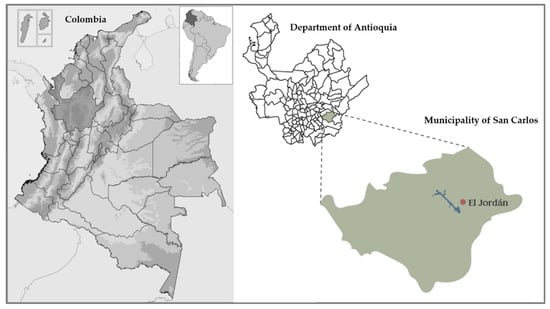
Figure 9.
Location of El Jordán, San Carlos (Antioquia).
San Carlos is a municipality with a fish farming tradition that strategically has capacities for fingerling production. Specifically, the El Jordán area has an average climate between 18–25 °C, and the availability of water through its watersheds makes it optimal for fish production and establishing production chains.
In contrast, this territory was affected by the armed conflict during the 1990s, which generated poverty and backwardness in its social and economic development. Currently, the region is experiencing post-conflict economic growth, where technology adoption is required to strengthen value chains such as fish farming and thereby generate job opportunities for the rural community.
Two pilot were formulated for its implementation by the rural community of the municipality of San Carlos to guarantee the sustainability of this research:
- Production of Spirulina sp. as raw material by the farmers
- Production of fish food incorporating the Spirulina produced.
A model of social appropriation of knowledge was implemented in which the research group CIBIOT of the Universidad Pontificia Bolivariana installed a set of five bioreactors equal to the number of families in rural areas of the municipality of San Carlos and trained them in the methodology to produce microalgae as discussed in this article. Each bioreactor was 315 L capacity, coupled with a solar panel as renewable energy system for the operation of an air pump that supplies aeration to the system, as shown in Figure 10.
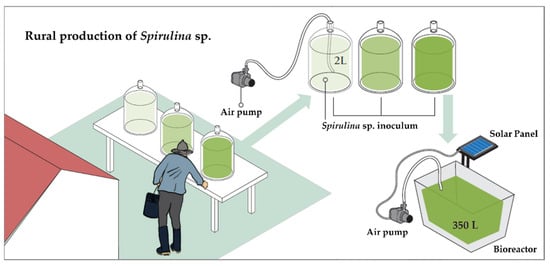
Figure 10.
Schema for sustainable production of Spirulina sp. in rural areas. Inoculum preparation and pilot production in 350 L bioreactor.
After generating the infrastructure conditions and the appropriation of knowledge to produce Spirulina sp., a model of community production of fish food is proposed. Under this model, each farmer produces Spirulina sp. on his farm, stores and transports it to a collection center where the fish feed production process is carried out by processing the agro-industrial residues of cassava leaf flours, gliricidia leaves, and rice husk, which are present in the region.
Under this model, farmers recognize that a job opportunity is created that complements their free time and adds value to the family economy. With the development of this pilot test, it was estimated that the time a farmer invests in the production of Spirulina sp. is equivalent to two days of work each month. The model is schematized in Figure 11.
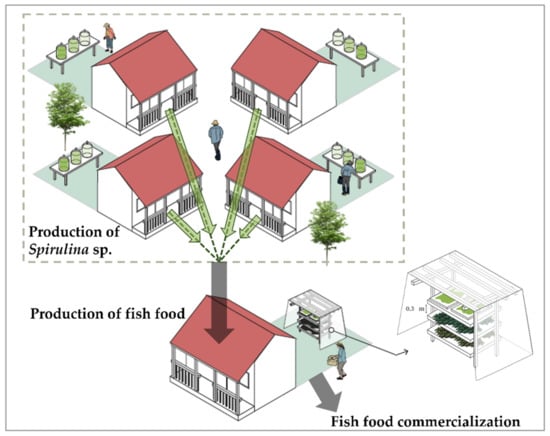
Figure 11.
Model for fish food production from agro-industrial residues enhanced with locally produced Spirulina sp. in the rural community of El Jordán, Antioquia.
4. Conclusions
The composition of the cultivated Spirulina sp. presented a percentage of 6.79% ± 0.05 of moisture, 6.93% ± 0.01 of ash, 66.88% ± 0.33 of protein and 5.50% ± 0.26 of fat, which allows it to be used as fish food, especially Tilapia since they require a source of protein of 35–45% and fat of 10–15%.
The results of the characterization of cassava leaf flours, gliricidia leaves, and rice husk show that this mixture of these three raw materials plus spirulina, has great application in the production of pellet-type fish food, due to its proximal composition are within the reference values, more than 79% of the particles are less than 500 µm, the cohesion index of for cassava leaf flour, gliricidia leaf flour, and rice husk flour was 19.22, 24.14 and 20.29 respectively and the results of the analysis of powders confirm that the particle size of the raw materials can play an important role in terms of the parameters of the extrusion system and the quality of the granules.
It was possible to produce fish food in the form of pellets using Spirulina sp. and agro-industrial waste flours: cassava leaves, gliricidia leaves and rice husk with 60% floating for more than 40 min, 80% of the pellets kept their shape for 4 h, keeping the micronutrients longer in the pellets.
Two pilot were formulated for its implementation by the rural community of the mu-nicipality of San Carlos to guarantee the sustainability of this research, comprising the production of Spirulina sp. as raw material by the farmers and therefore the production of fish food incorporating the Spirulina sp. produced. The model proposed opportunities for economic growth and the implementation of green technologies for rural families.
Author Contributions
Conceptualization, M.R.-C., D.S.-O., C.O.-L. and L.R.-C.; Methodology, M.R.-C., C.O.-L., D.S.-O. and L.R.-C.; validation, M.R.-C., L.R.-C., C.O.-L. and D.S.-O.; formal analysis, M.R.-C., L.R.-C., D.S.-O. and C.O.-L.; investigation, M.R.-C., D.S.-O., C.O-L. and L.R.-C.; resources, M.R.-C.; data curation, C.O.-L.; writing—original draft preparation, M.R.-C., D.S.-O., C.O-L. and L.R.-C.; writing—review and editing, M.R.-C., L.R.-C. and C.O.-L.; visualization C.O.-L.; funding acquisition, M.R.-C. All authors have read and agreed to the published version of the manuscript.
Funding
This research was funded by MINCIENCIAS and The Government of Antioquia, grant number 80740-009-2019 and the APC was funded by Universidad Pontificia Bolivariana.
Institutional Review Board Statement
Not applicable.
Informed Consent Statement
Not applicable.
Data Availability Statement
Not applicable.
Conflicts of Interest
The authors declare no conflict of interest.
References
- Duque-Acevedo, M.; Belmonte-Ureña, L.J.; Cortés-García, F.J.; Camacho-Ferre, F. Agricultural waste: Review of the evolution, approaches and perspectives on alternative uses. Glob. Ecol. Conserv. 2020, 22, e00902. [Google Scholar] [CrossRef]
- Obi, F.O.; Ugwuishiwu, B.O.; Nwakaire, J.N. Agricultural waste concept, generation, utilization and management. Niger. J. Technol. 2016, 35, 957–964. [Google Scholar] [CrossRef]
- Bedekar, P.A.; Bhalkar, B.N.; Patil, S.M.; Govindwar, S.P. Moringa oleifera-mediated coagulation of textile wastewater and its biodegradation using novel consortium-BBA grown on agricultural waste substratum. Environ. Sci. Pollut. Res. 2016, 23, 20963–20976. [Google Scholar] [CrossRef] [PubMed]
- Castro, A.; Da Silva Batista, N.; Latawiec, A.; Rodrigues, A.; Strassburg, B.; Silva, D.; Araujo, E.; De Moraes, L.; Guerra, J.; Galvão, G.; et al. The Effects of Gliricidia-Derived Biochar on Sequential Maize and Bean Farming. Sustainability 2018, 10, 578. [Google Scholar] [CrossRef] [Green Version]
- Mak, T.M.W.; Xiong, X.; Tsang, D.C.W.; Yu, I.K.M.; Poon, C.S. Sustainable food waste management towards circular bioeconomy: Policy review, limitations and opportunities. Bioresour. Technol. 2020, 297, 122497. [Google Scholar] [CrossRef]
- Youenou, B.; Hien, E.; Deredjian, A.; Brothier, E.; Favre-Bonté, S.; Nazaret, S. Impact of untreated urban waste on the prevalence and antibiotic resistance profiles of human opportunistic pathogens in agricultural soils from Burkina Faso. Environ. Sci. Pollut. Res. 2016, 23, 25299–25311. [Google Scholar] [CrossRef] [Green Version]
- Miskat, M.I.; Ahmed, A.; Chowdhury, H.; Chowdhury, T.; Chowdhury, P.; Sait, S.; Park, Y.-K. Assessing the Theoretical Prospects of Bioethanol Production as a Biofuel from Agricultural Residues in Bangladesh: A Review. Sustainability 2020, 12, 8583. [Google Scholar] [CrossRef]
- Lansche, J.; Awiszus, S.; Latif, S.; Müller, J. Potential of Biogas Production from Processing Residues to Reduce Environmental Impacts from Cassava Starch and Crisp Production—A Case Study from Malaysia. Appl. Sci. 2020, 10, 2975. [Google Scholar] [CrossRef]
- Patsios, S.I.; Dedousi, A.; Sossidou, E.N.; Zdragas, A. Sustainable Animal Feed Protein through the Cultivation of YARROWIA Lipolytica on Agro-Industrial Wastes and by-Products. Sustainability 2020, 12, 1398. [Google Scholar] [CrossRef] [Green Version]
- Garcia-Garcia, G.; Stone, J.; Rahimifard, S. Opportunities for waste valorisation in the food industry—A case study with four UK food manufacturers. J. Clean. Prod. 2019, 211, 1339–1356. [Google Scholar] [CrossRef]
- Choi, W.M.; Lam, C.L.; Mo, W.Y.; Wong, M.H. The use of food wastes as feed ingredients for culturing grass carp (Ctenopharyngodon idellus) in Hong Kong. Environ. Sci. Pollut. Res. 2016, 23, 7178–7185. [Google Scholar] [CrossRef] [PubMed]
- Cadillo-Benalcazar, J.J.; Giampietro, M.; Bukkens, S.G.F.; Strand, R. Multi-scale integrated evaluation of the sustainability of large-scale use of alternative feeds in salmon aquaculture. J. Clean. Prod. 2020, 248, 119210. [Google Scholar] [CrossRef]
- Gasco, L.; Biancarosa, I.; Liland, N.S. From waste to feed: A review of recent knowledge on insects as producers of protein and fat for animal feeds. Curr. Opin. Green Sustain. Chem. 2020, 23, 67–79. [Google Scholar] [CrossRef]
- Meyfroidt, P. Trade-offs between environment and livelihoods: Bridging the global land use and food security discussions. Glob. Food Sec. 2018, 16, 9–16. [Google Scholar] [CrossRef]
- Adéyèmi, A.D.; Kayodé, A.P.P.; Chabi, I.B.; Odouaro, O.B.O.; Nout, M.J.; Linnemann, A.R. Screening local feed ingredients of Benin, West Africa, for fish feed formulation. Aquac. Rep. 2020, 17, 100386. [Google Scholar] [CrossRef]
- Kok, B.; Malcorps, W.; Tlusty, M.F.; Eltholth, M.M.; Auchterlonie, N.A.; Little, D.C.; Harmsen, R.; Newton, R.W.; Davies, S.J. Fish as feed: Using economic allocation to quantify the Fish In: Fish Out ratio of major fed aquaculture species. Aquaculture 2020, 528, 735474. [Google Scholar] [CrossRef]
- Rosas, V.T.; Poersch, L.H.; Romano, L.A.; Tesser, M.B. Feasibility of the use of Spirulina in aquaculture diets. Rev. Aquac. 2019, 11, 1367–1378. [Google Scholar] [CrossRef]
- Dineshbabu, G.; Goswami, G.; Kumar, R.; Sinha, A.; Das, D. Microalgae–nutritious, sustainable aqua- and animal feed source. J. Funct. Foods 2019, 62, 103545. [Google Scholar] [CrossRef]
- Torres-Tiji, Y.; Fields, F.J.; Mayfield, S.P. Microalgae as a future food source. Biotechnol. Adv. 2020, 41, 107536. [Google Scholar] [CrossRef]
- Dewi, E.N.; Amalia, U.; Mel, M. The Effect of Different Treatments to the Amino Acid Contents of Micro Algae Spirulina sp. Aquat. Procedia 2016, 7, 59–65. [Google Scholar] [CrossRef]
- Abdelkhalek, N.K.M.; Eissa, I.A.M.; Ahmed, E.; Kilany, O.E.; El-Adl, M.; Dawood, M.; Hassan, A.M.; Abdel-Daim, M.M. Protective role of dietary Spirulina platensis against diazinon-induced Oxidative damage in Nile tilapia; Oreochromis niloticus. Environ. Toxicol. Pharmacol. 2017, 54, 99–104. [Google Scholar] [CrossRef] [PubMed]
- Sankarapandian, V.; Nitharsan, K.; Parangusadoss, K.; Gangadaran, P.; Ramani, P.; Maran, B.A.V.; Jogalekar, M.P. Prebiotic Potential and Value-Added Products Derived from Spirulina laxissima SV001—A Step towards Healthy Living. BioTech 2022, 11, 13. [Google Scholar] [CrossRef]
- Mukherjee, S.; Bhattacharya, S. Characterization of agglomeration process as a function of moisture content using a model food powder. J. Texture Stud. 2006, 37, 35–48. [Google Scholar] [CrossRef]
- Abdullah, E.; Salam, A.; Aziz, A. Cohesiveness and Flowability Properties of Silica Gel Powder. Phys. Int. 2010, 1, 16–21. [Google Scholar] [CrossRef] [Green Version]
- Seth, D.; Rajamanickam, G. Development of extruded snacks using soy, sorghum, millet and rice blend—A response surface methodology approach. Int. J. Food Sci. Technol. 2012, 47, 1526–1531. [Google Scholar] [CrossRef]
- Arroyo, M. Aprovechamiento de La Harina de Plecostomus Spp Como Ingrediente En Alimento Para El Crecimiento de Tilapia (Oreochromis Niloticus); Instituto Politécnico Nacional de México: Mexico City, Mexico, 2008. [Google Scholar]
- Nicoletti, M. Microalgae Nutraceuticals. Foods 2016, 5, 54. [Google Scholar] [CrossRef]
- Becker, W. Handbook of Microalgal Culture; Blackwell Publishing Ltd.: Oxford, UK, 2004; pp. 380–391. [Google Scholar]
- Altmann, B.A.; Rosenau, S. Spirulina as Animal Feed: Opportunities and Challenges. Foods 2022, 11, 965. [Google Scholar] [CrossRef]
- Toughan, H.; Khalil, S.R.; El-Ghoneimy, A.A.; Awad, A.; Seddek, A.S. Effect of dietary supplementation with Spirulina platensis on Atrazine-induced oxidative stress- mediated hepatic damage and inflammation in the common carp (Cyprinus carpio L.). Ecotoxicol. Environ. Saf. 2018, 149, 135–142. [Google Scholar] [CrossRef]
- Rojas, E.; Ávila, M.; Parada, G. Application of nutritional strategies and their effect in continuous culture of Spirulina (Arthrospira platensis). Lat. Am. J. Aquat. Res. 2012, 40, 763–771. [Google Scholar] [CrossRef]
- Delrue, F.; Alaux, E.; Moudjaoui, L.; Gaignard, C.; Fleury, G.; Perilhou, A.; Richaud, P.; Petitjean, M.; Sassi, J.-F. Optimization of Arthrospira platensis (Spirulina) Growth: From Laboratory Scale to Pilot Scale. Fermentation 2017, 3, 59. [Google Scholar] [CrossRef] [Green Version]
- Colla, L.M.; Oliveira Reinehr, C.; Reichert, C.; Costa, J.A.V. Production of biomass and nutraceutical compounds by Spirulina platensis under different temperature and nitrogen regimes. Bioresour. Technol. 2007, 98, 1489–1493. [Google Scholar] [CrossRef] [PubMed]
- El-Bahr, S.; Shousha, S.; Shehab, A.; Khattab, W.; Ahmed-Farid, O.; Sabike, I.; El-Garhy, O.; Albokhadaim, I.; Albosadah, K. Effect of Dietary Microalgae on Growth Performance, Profiles of Amino and Fatty Acids, Antioxidant Status, and Meat Quality of Broiler Chickens. Animals 2020, 10, 761. [Google Scholar] [CrossRef] [PubMed]
- Çelekli, A.; Yavuzatmaca, M.; Bozkurt, H. Modeling of biomass production by Spirulina platensis as function of phosphate concentrations and pH regimes. Bioresour. Technol. 2009, 100, 3625–3629. [Google Scholar] [CrossRef] [PubMed]
- Jung, C.H.G.; Braune, S.; Waldeck, P.; Küpper, J.-H.; Petrick, I.; Jung, F. Morphology and Growth of Arthrospira platensis during Cultivation in a Flat-Type Bioreactor. Life 2021, 11, 536. [Google Scholar] [CrossRef] [PubMed]
- Benemann, J. Microalgae for Biofuels and Animal Feeds. Energies 2013, 6, 5869–5886. [Google Scholar] [CrossRef] [Green Version]
- Pantoja, J.O.; Sánchez, S.; Hoyos, J.L. Obtención de un alimento extruido para tilapia roja (oreochromis spp) utilizando ensilaje biológico de pescado. Biotecnol. En El Sect. Agropecu. Y Agroind. 2011, 9, 178–186. [Google Scholar]
- Lara, R.; Castro, T.; Castro, J.; Castro, G.; Malpica Sánchez, A.; García Castillo, V. La importancia de Spirulina en la alimentación acuícola. Contactos 2005, 57, 13–14. [Google Scholar]
- Lucas, B.F.; de Morais, M.G.; Santos, T.D.; Costa, J.A.V. Spirulina for snack enrichment: Nutritional, physical and sensory evaluations. LWT 2018, 90, 270–276. [Google Scholar] [CrossRef]
- Rosenau, S.; Oertel, E.; Dietz, C.; Wessels, S.; Tetens, J.; Mörlein, D.; Ciulu, M. Total Replacement of Fishmeal by Spirulina (Arthrospira platensis) and Its Effect on Growth Performance and Product Quality of African Catfish (Clarias gariepinus). Sustainability 2021, 13, 8726. [Google Scholar] [CrossRef]
- Ramírez-Rodrigues, M.M.; Estrada-Beristain, C.; Metri-Ojeda, J.; Pérez-Alva, A.; Baigts-Allende, D.K. Spirulina platensis protein as sustainable ingredient for nutritional food products development. Sustainability 2021, 13, 6849. [Google Scholar] [CrossRef]
- Hemaiswarya, S.; Raja, R.; Ravi Kumar, R.; Ganesan, V.; Anbazhagan, C. Microalgae: A sustainable feed source for aquaculture. World J. Microbiol. Biotechnol. 2011, 27, 1737–1746. [Google Scholar] [CrossRef]
- Ramírez-Carmona, M.; Casas, E.; Orrego, E.; Acevedo, A.; Giraldo, S. Biomasa de Residuos Agrícolas en el Departamento de Antioquia; Universidad Pontificia Bolivariana: Medellin, Colombia, 2010. [Google Scholar]
- Burns, A.; Gleadow, R.; Cliff, J.; Zacarias, A.; Cavagnaro, T. Cassava: The Drought, War and Famine Crop in a Changing World. Sustainability 2010, 2, 3572–3607. [Google Scholar] [CrossRef] [Green Version]
- FAO. Norme Générale Codex Pour les Additifs Alimentaires; FAO: Rome, Italy, 2015.
- Romero, N.; Areche, C.; Cubides-Cárdenas, J.; Escobar, N.; García-Beltrán, O.; Simirgiotis, M.J.; Céspedes, Á. In Vitro Anthelmintic Evaluation of Gliricidia sepium, Leucaena leucocephala, and Pithecellobium dulce: Fingerprint Analysis of Extracts by UHPLC-Orbitrap Mass Spectrometry. Molecules 2020, 25, 3002. [Google Scholar] [CrossRef]
- Compean-Martínez, J.; Salazar-Ulloa, M.; Chávez-Soriano, L.; Muñoz-Córdoba, G.; Son-de Fernex, E. Anthelmintic-like Activity of Leucaena leucocephala Aqueous Extract Against Gyrodactylus spp. in Naturally Infected Tilapia Fingerlings. N. Am. J. Aquac. 2021, 83, 354–362. [Google Scholar] [CrossRef]
- Barbosa-Cánovas, G.; Juliano, P. Encapsulated and Powdered Foods; CRC Press: Boca Raton, FL, USA, 2005; pp. 41–70. [Google Scholar]
- Dhanalakshmi, K.; Ghosal, S.; Bhattacharya, S. Agglomeration of Food Powder and Applications. Crit. Rev. Food Sci. Nutr. 2011, 51, 432–441. [Google Scholar] [CrossRef]
- Feng, J.Q.; Hays, D.A. Relative importance of electrostatic forces on powder particles. Powder Technol. 2003, 135–136, 65–75. [Google Scholar] [CrossRef]
- Bhandari, B.; Ho, T. Handbook of Food Preservation; CRC Press: New York, NY, USA, 2020; pp. 387–402. [Google Scholar]
- Bika, D.; Tardos, G.I.; Panmai, S.; Farber, L.; Michaels, J. Strength and morphology of solid bridges in dry granules of pharmaceutical powders. Powder Technol. 2005, 150, 104–116. [Google Scholar] [CrossRef]
- Martin, A.; Osen, R.; Greiling, A.; Karbstein, H.P.; Emin, A. Effect of rapeseed press cake and peel on the extruder response and physical pellet quality in extruded fish feed. Aquaculture 2019, 512, 734316. [Google Scholar] [CrossRef]
- Berman, A. Optimización Del Proceso de Extrusión Para La Elaboración de Pelets Para Alimentación de Tilapia (Oreochromis Niloticus) En Zamorano; Escuela Agrícola Panamericana: Tegucigalpa, Honduras, 2007. [Google Scholar]
- Hoyos-Concha, J.L.; Villada-Castillo, H.S.; Fernández-Quintero, A.; Ortega-Toro, R. Use of trout by-products (Oncorhynchus mykiss) for the production of an extruded fish feed. Rev. Mex. Ing. Química 2022, 21, 1–13. [Google Scholar] [CrossRef]
- Kabir, K.A.; Verdegem, M.C.J.; Verreth, J.A.J.; Phillips, M.J.; Schrama, J.W. Dietary non-starch polysaccharides influenced natural food web and fish production in semi-intensive pond culture of Nile tilapia. Aquaculture 2020, 528, 735506. [Google Scholar] [CrossRef]
- Fagbenro, O.A.; Jauncey, K. Physical and nutritional properties of moist fermented fish silage pellets as a protein supplement for tilapia (Oreochromis niloticus). Anim. Feed Sci. Technol. 1998, 71, 11–18. [Google Scholar] [CrossRef]
- Mo, W.Y.; Lun, C.H.I.; Choi, W.M.; Man, Y.B.; Wong, M.H. Enhancing growth and non-specific immunity of grass carp and Nile tilapia by incorporating Chinese herbs (Astragalus membranaceus and Lycium barbarum) into food waste based pellets. Environ. Pollut. 2016, 219, 475–482. [Google Scholar] [CrossRef] [PubMed]
- Abdel-Tawwab, M.; El-Sayed, G.O.; Shady, S.H. Growth, biochemical variables, and zinc bioaccumulation in Nile tilapia, Oreochromis niloticus (L.) as affected by water-born zinc toxicity and exposure period. Int. Aquat. Res. 2016, 8, 197–206. [Google Scholar] [CrossRef] [Green Version]
- Fagbenro, O.; Jauncey, K. Chemical and nutritional quality of stored fermented fish (tilapia) silage. Bioresour. Technol. 1993, 46, 207–211. [Google Scholar] [CrossRef]
- Kanmani, N.; Romano, N.; Ebrahimi, M.; Nurul Amin, S.M.; Kamarudin, M.S.; Karami, A.; Kumar, V. Improvement of feed pellet characteristics by dietary pre-gelatinized starch and their subsequent effects on growth and physiology in tilapia. Food Chem. 2018, 239, 1037–1046. [Google Scholar] [CrossRef]
- Makwinja, R.; Geremew, A. Roles and requirements of trace elements in tilapia nutrition: Review. Egypt. J. Aquat. Res. 2020, 46, 281–287. [Google Scholar] [CrossRef]
- Berntssen, M.H.G.; Thoresen, L.; Albrektsen, S.; Grimaldo, E.; Grimsmo, L.; Whitaker, R.D.; Sele, V.; Wiech, M. Processing Mixed Mesopelagic Biomass from the North-East Atlantic into Aquafeed Resources; Implication for Food Safety. Foods 2021, 10, 1265. [Google Scholar] [CrossRef]
- Manomaitis, L.; Cremer, M. Growth Performance of Tilapia Fed Soy-Based Feed in Low Volume, High Density Cages on Phu Long Reservoir, Dalai, Ninh Binh, Yen Khanh District, Vietnam; Results of ASA-IM/Soy-in-Aquaculture; American Soybean Association International Marketing (ASA-IM): St. Louis, MO, USA, 2006. [Google Scholar]
- Jagtap, S.; Garcia-Garcia, G.; Duong, L.; Swainson, M.; Martindale, W. Codesign of Food System and Circular Economy Approaches for the Development of Livestock Feeds from Insect Larvae. Foods 2021, 10, 1701. [Google Scholar] [CrossRef]
Publisher’s Note: MDPI stays neutral with regard to jurisdictional claims in published maps and institutional affiliations. |
© 2022 by the authors. Licensee MDPI, Basel, Switzerland. This article is an open access article distributed under the terms and conditions of the Creative Commons Attribution (CC BY) license (https://creativecommons.org/licenses/by/4.0/).